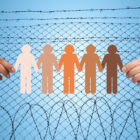
Vote to Turn Tragedy for Young Black Men Into Hope
|
2018 has already been another year of tension in cities across the country between police officers and young black males.
Juvenile Justice Information Exchange (https://jjie.org/category/ideas-and-opinions/page/35/)

2018 has already been another year of tension in cities across the country between police officers and young black males.

Dayonn Davis was 15 when he committed a crime that would get him tried in court as an adult. A Facebook sale of a pair of Oreo Nikes, priced at around $100, went sour when the Columbus, Georgia teen attempted to steal them.

In 2012, the U.S. Attorney General appointed a national task force on children exposed to violence that concluded, “Nowhere is the impact of incarceration on vulnerable children more obvious than when it involves solitary confinement.” This statement still holds true and solitary confinement bears an even heavier impact on incarcerated youth today.

As a passionate advocate for children and families to thrive and recognizing the barriers and violence created by racism, I’d like to share some reflections on the journey toward racial equity that we are taking in Broward County, Florida.

I have worked since 1981 with teenagers who are homeless, runaways, addicted to drugs and alcohol, in the criminal justice system, former gang members and victims of abuse and neglect. I am now the director of Spectrum Youth and Family Services, the largest program in Vermont for this population.

Rampant violence and civil rights abuses in juvenile prisons are prompting calls to shut them down.

The approach to the treatment of youthful offenders has changed dramatically in the last 20 years. Systemic models that once focused on using vocational training as a means of rehabilitation have recently evolved into mental health-focused treatment programs and reentry efforts.

The Youth Today/InsideOUT Writers series these past two years has been a critical reflection on the impact of the American justice system on our youth, how these youth learn to navigate through that system and the ways in which many of these youth nevertheless find ways to humanize themselves into healthy young adults.

Juvenile justice reinvestment, which shifts funding from corrections-based approaches toward cost-effective community-based services for youth, has gained momentum in states throughout the U.S. in recent years.

For juvenile court judges, correctional facility administrators and community supervision agency leaders throughout the country, the progress juvenile justice systems have made in recent years is clear. Nationwide, juvenile arrest rates are at historic lows, and incarceration rates have plummeted by more than half.